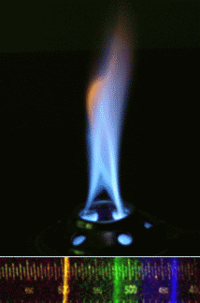
Photo from wikipedia
Abstract One-dimensional hybrid fs/ps CARS imaging provides single-laser-shot measurements of temperature, oxygen, and hydrogen in a plasma-assisted hydrogen diffusion flame. The coaxial dielectric-barrier-discharge burner collapses the Re ∼50 hydrogen diffusion… Click to show full abstract
Abstract One-dimensional hybrid fs/ps CARS imaging provides single-laser-shot measurements of temperature, oxygen, and hydrogen in a plasma-assisted hydrogen diffusion flame. The coaxial dielectric-barrier-discharge burner collapses the Re ∼50 hydrogen diffusion flame to within ∼5 mm of the burner surface at an applied AC potential of 8.75 kV at 18 kHz, coinciding nicely with the full spatial extent of the 1D CARS measurements. Translating the burner through the measurement volume allowed for measurements at numerous radial locations in increments of 1 mm with a resolution of 140 µm × 30 µm × 600 µm, sufficient to resolve spatial gradients in this unsteady flame. Longer probe delays, required for improved dynamic range in regions of high temperature fluctuations, proved difficult to model as a result of a nontrivial decay in the O2 Raman coherence arising from complexities associated with the triplet ground electronic state of the O2 molecule. Oxygen linewidths were treated empirically using the observed O2 coherence decay in spectra acquired from the product gases of lean, near-adiabatic H2/air flames stabilized on a Hencken flat-flame burner. While still leading to errors up to 10% at worst, the empirically determined Raman linewidth factors eliminated any systematic error in the O2/N2 measurements with probe delay. Temperature measurements in the Hencken Burner flames proved to be insensitive to probe pulse delay, providing robust thermometry. Demonstration of this technique in both the canonical Hencken burner flames and a new DBD burner validates its effectiveness in producing multiple spatially resolved measurements in combustion environments. Measurements in the DBD burner revealed an unsteady, counterflow flattened flame structure near the fuel orifice which became unsteady as the reaction zone curves towards the surface for larger radial positions. Fluctuations in the fuel concentration were largest at the source, as the large, plasma-generated, unsteady external toroidal vortex that dominates the transport in this flame provides enhanced ventilation of the flame surface in close proximity to the fuel tube.
Journal Title: Combustion and Flame
Year Published: 2018
Link to full text (if available)
Share on Social Media: Sign Up to like & get
recommendations!